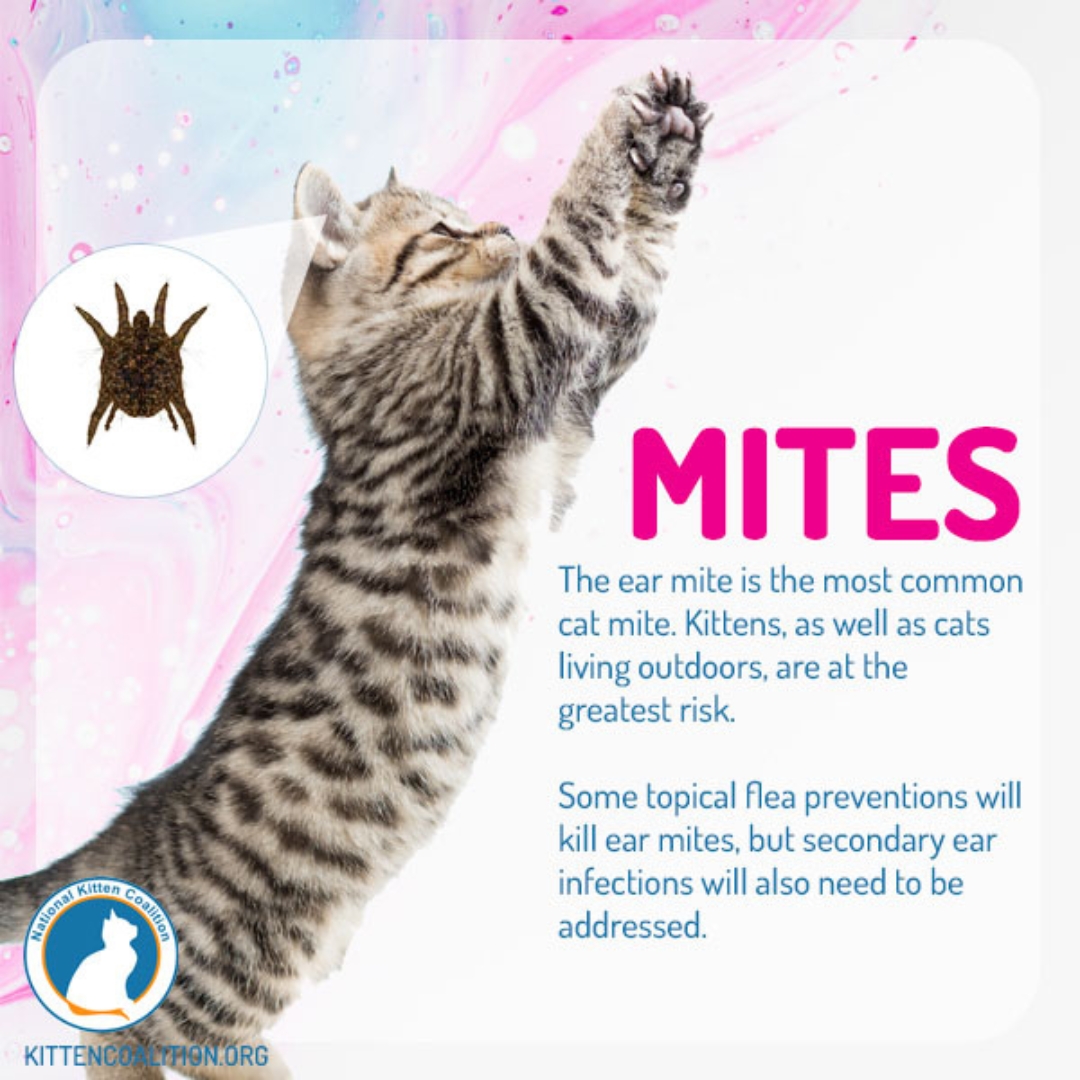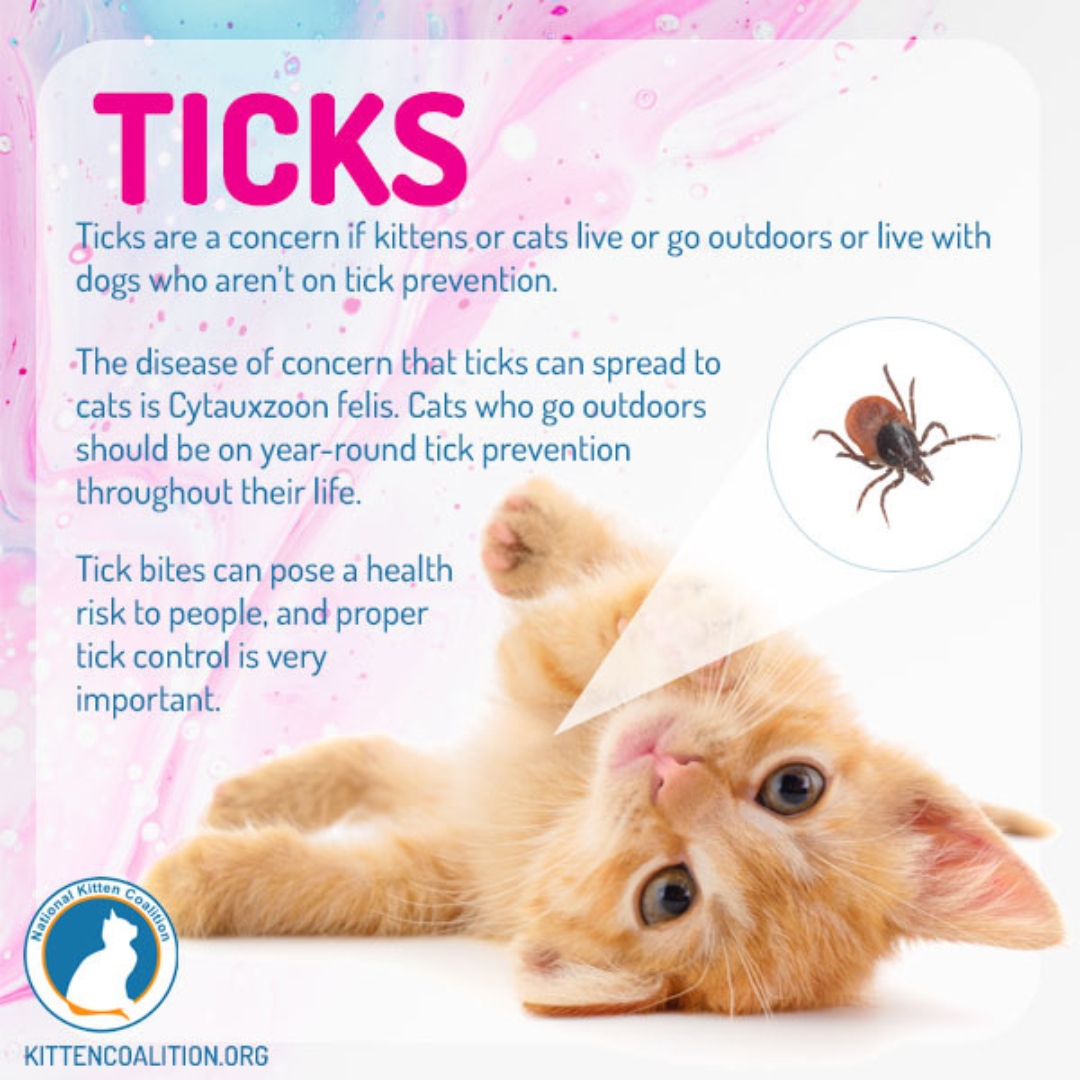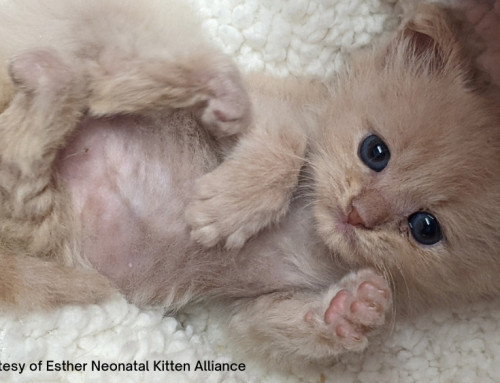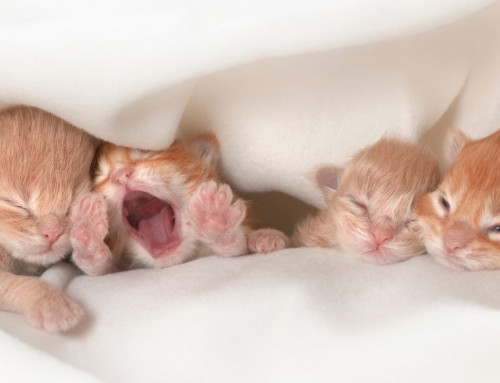Share this resource or email it to a friend!
A parasite is an organism that lives in a host organism and gets its food from or at the expense of its host. Ectoparasites are those that live on the outside of its host. You may see endoparasites with your naked eye or the signs that they are present. For example, flea dirt, which looks like black pepper, is actually flea excrement. When moistened the specks turn red because they contain blood that the flea sucked from the host’s skin. Another example is the sign of the presence of ear mites, which looks like coffee grounds and is their excrement.
Fleas and lice are insects, and ticks and mites are arachnids. These ectoparasites belong to the largest phylum in the animal kingdom, Arthropods.
Not all products for treating parasites on cats are safe to use on kittens. Always check with a veterinarian, especially when treating kittens.
Fleas
Fleas are not only a nuisance; they can cause anemia, allergic reactions and transmit diseases, such as Feline bartonella, a condition caused by a bacterium found in flea and tick feces. Cats contract bartonella primarily when flea feces are present on their fur or skin and they lick up the debris and bacteria while grooming. Symptoms of feline bartonella include swollen glands, lethargy, or sore muscles, and veterinary treatment, may include antibiotics. Feline bartonella can cause cat scratch fever in people.
Small kittens are especially prone to anemia, a lack of healthy red blood cells to carry oxygen to the body’s tissues, caused by fleas when they live in an environment with a high flea population. Flea anemia can be life threatening if not treated quickly and appropriately.
In order to limit the flea population on kittens who live in areas of the country where fleas exist, they should receive appropriate year-round flea prevention throughout their lives. Although about only 5% of a flea population is adult fleas living on kittens or cats, all pets in the household must be treated.
Topical products are available that kill adult fleas as well as help control the population although sometimes environmental treatment is also indicated because 95% of fleas are found in the home. Once established, it will take several months to bring the numbers under control.
Mites
The ear mite, Otodectes cynotis, is the most common mite found on cats. Kittens, as well as cats living outdoors, are at the greatest risk. Ear mites cause inflammation of the ear canal; they often cause secondary infections, mostly bacterial, fungal or both.
Symptoms of ear mites include head shaking and ear scratching; inflammation (an immune system reaction in which a part of the body becomes reddened, swollen, hot and often painful) of the ear canals; accumulation of copious cerumen (earwax) and frequently serous (clear, liquid part of blood) to purulent (pus) drainage, depending on the secondary infectious agents.
Mites in the ear may be observed by a veterinarian with an otoscope or from samples from the ear canal placed in oil on a slide and observed under a microscope. Some topical flea preventions will kill ear mites, but secondary ear infections will also need to be addressed.
Ticks
Ticks are a less common parasitic concern for kittens and cats who live strictly indoors. However, ticks can remain a concern if kittens or cats live or go outdoors or live with dogs who are not on tick prevention.
Ticks can spread various infections to cats, including:
- Cytauxzoon is the major disease of concern It’s a life-threatening disease caused by Cytauxzoon felis, a protozoal parasite. Bobcats are the natural reservoir host, and the disease is transmitted to cats by tick bites, primarily the lone star tick. The symptoms of Cytauxzoon may include: depression, lethargy, anorexia, fever and dehydration, enlargement of the spleen, liver and lymph nodes and pulmonary edema
- Cats become infected with Q fever, a zoonotic disease caused by Coxiella burnetii, by ingestion or inhalation of organisms from contaminated carcasses of farm animals or tick bites. Infected cats may not show symptoms or only vague symptoms, such as fever, lethargy and lack of appetite lasting several days. During parturition (birth), cats may shed organisms in birth fluids that contaminate bedding and other objects. People should wear gloves and a mask when attending parturient or aborting cats to minimize their risk of infection.
- Feline bartonella is also spread by ticks. See the section on fleas.
Any cats who goes outside should be on year-round tick prevention throughout their lives.
Lice
Lice live on and feed on a kitten’s skin and cause symptoms such as rubbing, scratching and biting of infested areas. Heavy infestations may cause severe pruritus (itchiness), which results in restlessness, intense scratching, a ruffled or rough, matted coat and even alopecia, areas of hair loss. Lice infestations are most common among kittens or debilitated cats living in unsanitary environments.
Lice are frequently treated with spot-on products, shampoos, collars, sprays or dusts. Because eggs may continue to hatch over 2 to 3 weeks, treatment should be repeated 7 to 10 days after the first treatment.
In addition to treating lice on kittens, their bedding, collars, grooming tools and other items in the home that may harbor eggs should be washed frequently in hot, soapy water or treated with an appropriate spray until the infestation is controlled.
Lice are host specific, meaning that the lice that parasitize cats do not affect other animals or humans. Lice do not present any health risks to people and can be easily controlled on cats with many of the flea preventives.
Zoonotic Considerations
A zoonotic disease is defined as one that can spread from animals to people. Flea and tick bites can pose a health risk to humans, and proper flea and tick control is very important.










